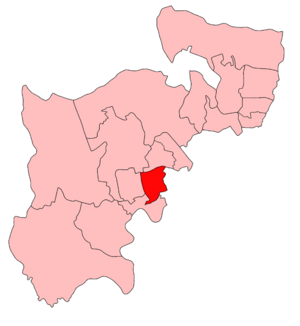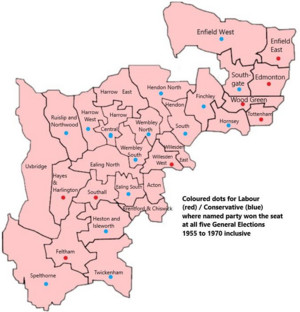Acton (UK Parliament constituency) facts for kids
Quick facts for kids {{{Name}}}[[{{{Type}}} constituency]] |
|
|---|---|
| [[Image:{{{Map1}}}Constituency.svg|120px|]] [[Image:England{{{Map2}}}.svg|120px|]] |
|
| {{{Name}}} shown within [[{{{Entity}}}]], and {{{Entity}}} shown within England | |
| Created: | {{{Year}}} |
| MP: | {{{MP}}} |
| Party: | {{{Party}}} |
| Type: | House of Commons |
| County: | [[{{{County}}}]] |
| EP constituency: | [[{{{EP}}} (European Parliament constituency)|{{{EP}}}]] |
Acton was a special area in the United Kingdom that elected one person to represent it in the House of Commons. The House of Commons is a very important part of the UK's Parliament, where laws are made.
This "constituency" (or electoral area) was first created for the election in 1918. It allowed people in Acton to choose their own Member of Parliament (MP). An MP is like a spokesperson for their area in Parliament.
The way they chose the MP was called the "first-past-the-post" system. This means the candidate who gets the most votes wins, even if they don't get more than half of all the votes.
The Acton constituency stopped existing for the 1983 general election. After that, it was replaced by a new area called Ealing Acton.
What Were the Boundaries of Acton?
How the Area Was First Created
The Acton electoral area was set up by a law called the Representation of the People Act in 1918. This law helped create more electoral areas in places where the population had grown a lot.
One such area was Middlesex, which was becoming more built-up as the city of London expanded. The Acton constituency was mainly based around the town of Acton itself.
It included the area known as the Acton Urban District. This district later became a "Municipal Borough" in 1921, which is a type of local government area.
Changes to the Boundaries Over Time
In 1950, there was a review of all the parliamentary areas. However, the boundaries for Acton didn't change at that time. The law simply reclassified it as a "borough constituency," which is a type of electoral area found in towns and cities.
Later, in 1965, the Acton area became part of the London Borough of Ealing. This also meant it became part of Greater London, which is the larger area that includes London and its surrounding towns.
Another big change happened before the election in February 1974. The area to the west, called Ealing South, was removed. Acton then took in most of that area to make sure it had enough voters, as its population had become quite small compared to other areas.
From 1983 onwards, the area was officially known as Ealing Acton.
Parts of the Acton Area
- 1918–1974: The Acton Municipal Borough. Even though the borough stopped existing in 1965 (when it became part of the London Borough of Ealing), the parliamentary area stayed the same for a while.
- 1974–1983: Six specific local areas (called wards) from the London Borough of Ealing. These were: Central, East, Hanger Hill, Heathfield, Southfield, and Springfield. This change meant the Acton area grew, especially along its western side.
Members of Parliament
A Member of Parliament (MP) is the person elected to represent a constituency in the House of Commons. They speak up for the people in their area and help make decisions about the country's laws.
Here are the people who were MPs for Acton:
| Election | Member | Party | |
|---|---|---|---|
| 1918 | Sir Harry Brittain | Unionist | |
| 1929 | James Shillaker | Labour | |
| 1931 | Hubert Duggan | Conservative | |
| 1943 | Henry Longhurst | Conservative | |
| 1945 | Joseph Sparks | Labour | |
| 1959 | Philip Holland | Conservative | |
| 1964 | Bernard Floud | Labour | |
| 1968 | Kenneth Baker | Conservative | |
| 1970 | Nigel Spearing | Labour | |
| 1974 | Sir George Young | Conservative | |
| 1983 | constituency abolished | ||
Elections
Elections are how people choose their representatives. In the Acton constituency, voters went to the polls many times to elect their Member of Parliament. The results below show who won each election and which political party they belonged to.
Elections in the 1910s
- 1918 General Election: Sir Harry Brittain (Unionist Party) won.
Elections in the 1920s
- 1922 General Election: Sir Harry Brittain (Unionist Party) won again.
- 1923 General Election: Sir Harry Brittain (Unionist Party) won for a third time.
- 1924 General Election: Sir Harry Brittain (Unionist Party) won again.
- 1929 General Election: James Shillaker (Labour Party) won, taking the seat from the Unionists.
Elections in the 1930s
- 1931 General Election: Hubert Duggan (Conservative Party) won the seat for the Conservatives.
- 1935 General Election: Hubert Duggan (Conservative Party) was re-elected.
Elections in the 1940s
- 1943 Acton By-election: Henry Longhurst (Conservative Party) won this special election.
- 1945 General Election: Joseph Sparks (Labour Party) won the seat for the Labour Party.
Elections in the 1950s
- 1950 General Election: Joseph Sparks (Labour Party) was re-elected.
- 1951 General Election: Joseph Sparks (Labour Party) won again.
- 1955 General Election: Joseph Sparks (Labour Party) won for a third time.
- 1959 General Election: Philip Holland (Conservative Party) won the seat for the Conservatives.
Elections in the 1960s
- 1964 General Election: Bernard Floud (Labour Party) won the seat for Labour.
- 1966 General Election: Bernard Floud (Labour Party) was re-elected.
- 1968 Acton By-election: Kenneth Baker (Conservative Party) won this special election for the Conservatives.
Elections in the 1970s
- 1970 General Election: Nigel Spearing (Labour Party) won the seat for Labour.
- February 1974 General Election: George Young (Conservative Party) won the seat for the Conservatives.
- October 1974 General Election: George Young (Conservative Party) was re-elected.
- 1979 General Election: George Young (Conservative Party) won again, holding the seat until it was abolished.





